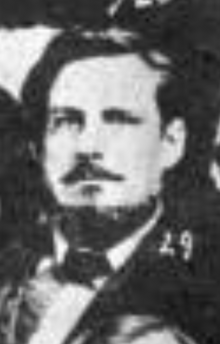| Samuel Barron Stephens | |
|---|---|
 | |
| Member of the Florida House of Representatives from the Gadsden district | |
| In office 1848 | |
| Member of the Florida Territorial Council from the Gadsden district | |
| In office 1841–1842 | |
| Personal details | |
| Born | 1814 New Bern, North Carolina, US |
| Died | August 4, 1882(1882-08-04) (aged 67–68) Quincy, Florida, US |
| Political party | Whig |
| Spouse | Caroline Booth |
| Children | 2 |
| Education | University of North Carolina at Chapel Hill |
| Military service | |
| Allegiance | |
| Branch/service | |
| Years of service | 1836–1838 (USA) 1865 (CSA) |
| Rank | |
| Unit | Florida Militia |
| Battles/wars | Second Seminole War American Civil War |
Samuel Barron Stephens (1814 – August 4, 1882) was an American attorney and politician from the state of Florida.
Biography
Stephens was born in New Bern, North Carolina, in 1814. After graduating from the University of North Carolina at Chapel Hill in 1832, Stephens and his family settled in the newly established Florida Territory due to personal debts held by his father, Marcus Cicero Stephens, settling in Gadsden County. Stephens established a successful law practice in Quincy, Florida, and soon became both the city attorney and county attorney.
In 1836, Stephens was mustered into the 1st brigade of the Florida Militia at Marianna, Florida, during the Second Seminole War, serving as a first lieutenant and company captain. Stephens' company was mustered out of service in 1838.
Stephens was a delegate at the Florida Constitutional Convention of 1838, and assisted in the writing of Florida's first constitution. A member of the Whig Party, Stephens was elected to the Florida Territorial Council in 1841, representing Gadsden County. He served until 1842. In 1848, he was elected to the Florida State House of Representatives, serving only one term.
In 1849, he was appointed by the Florida House of Representatives to be the solicitor for Florida's Middle Judicial Circuit Court, defeating Madison County attorney Barton C. Pope in the nomination vote.
In 1861, Stephens sat as a member of the Florida Secession Convention. Stephens, who owned 24 slaves at the time, voted for Florida's secession from the Union. He was also a signatory of the Florida Ordinance of Secession.
Stephens served in the Confederate States Army during the American Civil War, and participated in the Battle of Natural Bridge in 1865. A lieutenant at Natural Bridge, Stephens was promoted to colonel by the end of the war.
Stephens was also a prominent Freemason, serving as the Grand Master of the Grand Lodge of Florida in 1869, making him the highest ranking Mason in Florida at the time.
Stephens died on August 4, 1882, in Quincy.
Personal life

Stephens's wife was Caroline Booth, a descendant of William Fitzgerald, a captain in the American Revolutionary War. They had two daughters, Fannie and Caroline.
Stephens was closely related with the Kenan political family of North Carolina, and was a maternal descendant of James Barron, a commodore in the United States Navy and commander of the USS Chesapeake during the Chesapeake–Leopard affair in 1807.
Stephens's house in Quincy, the Colonel Samuel B. Stephens House, which was built between 1842 and 1850, is listed as one of Quincy's historic homes.
References
- "Historic Western Cemetery Walking Tour" (PDF). Quincy Main Street. Retrieved November 27, 2021.
- Jacksonville Genealogical Society (1972). Florida Militia Muster Rolls, Seminole Indian Wars. Vol. 10. St. Augustine: Florida Department of Military Affairs. p. 6. Retrieved November 27, 2021 – via University of Florida.
- Tallahassee Genealogical Society (1985). Tallahassee Genealogical Society Quarterly Issue 4-85 (PDF). Tallahassee. p. 7. Retrieved November 27, 2021.
{{cite book}}: CS1 maint: location missing publisher (link) - The People of Lawmaking in Florida 1822 - 2019 (PDF). Tallahassee: Florida House of Representatives. 2019. p. 177. ASIN B0084P8LC2. Retrieved November 27, 2021.
- Journal of the Proceedings of the Senate of the General Assembly of the State of Florida at its Fourth Session. Vol. 6. Tallahassee: The State of Florida. 1848. p. 149. Retrieved November 27, 2021 – via Google Books.
- Wooster, Ralph A. (1958). "The Florida Secession Convention". The Florida Historical Quarterly. 36 (4): 373–385. ISSN 0015-4113. JSTOR 30139845 – via JSTOR.
- Florida Ordinance of Secession. Tallahassee: State Library and Archives of Florida. 1861. Retrieved November 27, 2021 – via Florida Memory.
- ^ Stephens, Marcus Cicero (1835). Letter of Marcus C. Stephens. Quincy: The Florida Historical Quarterly. p. 5. Retrieved November 27, 2021 – via University of Central Florida.
- Rogers, William Warren; Clark, Erica R. (1999). The Croom Family and Goodwood Plantation: Land, Litigation, and Southern Lives. Athens: University of Georgia Press. p. 245. ISBN 978-0-8203-2069-4 – via Google Books.
- Grand Lodge of Florida (1988). "Manatee Lodge Number 31" (PDF). SunCoast Florida Freemasonry. Retrieved November 27, 2021.
- Johnston, Sarah Hall (1912). Lineage Book - National Society of the Daughters of the American Revolution. Vol. 36. Washington, D.C.: Daughters of the American Revolution. p. 78 – via Google Books.
- Register, Alvaretta Kenan (1967). The Kenan family and some allied families of the compiler and publisher. University of North Carolina at Chapel Hill. Statesboro: J. S. Kenan II. LCCN 68002437. OL 5596736M. Retrieved November 27, 2021 – via Archive.org.
- "Historic Homes". Gadsden County, Florida. 2015-10-20. Retrieved 2021-11-28.
- 1814 births
- 1882 deaths
- Florida Whigs
- Members of the Florida House of Representatives
- People of Florida in the American Civil War
- 19th-century American lawyers
- American Freemasons
- Politicians from New Bern, North Carolina
- People from Quincy, Florida
- Confederate States Army officers
- Florida National Guard personnel
- 19th-century members of the Florida Legislature